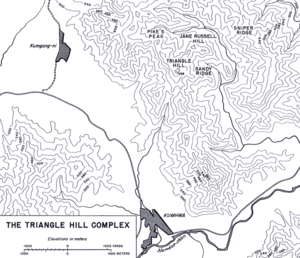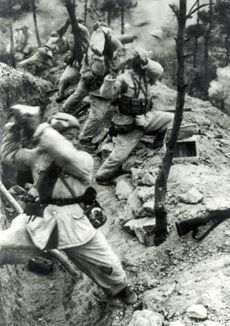معركة الربوة المثلثة
| معركة الربوة المثلثة Battle of Triangle Hill | |||||||
|---|---|---|---|---|---|---|---|
| جزء من الحرب الكورية | |||||||
 خريطة منطقة الربوة المثلثة | |||||||
| |||||||
| المتحاربون | |||||||
|
| |||||||
| القادة والزعماء | |||||||
|
|
Deng Hua Wang Jinshan[4] Qin Jiwei Li Desheng[5] Cui Jiangong | ||||||
| الوحدات المشاركة | |||||||
|
|
15th Corps[nb 2] 12th Corps | ||||||
| القوى | |||||||
|
المشاة: غير معروف المدفعية: 288 مدفع[8] الطيران: 2,200+ sorties[9] |
المشاة: 50,000[10] المدفعية: 133 مدفع، 24 قاذفات صواريخ مدفعية مضادة للطائرات: 47 مدفع[11] | ||||||
| الضحايا والخسائر | |||||||
|
الولايات المتحدة: 365 قتيل 1,174 جريح 1 أسير[12] كوريا الجنوبية: 1,096 قتيل 3,496 جريح 97 مفقود[13] التقدير الصيني: 25,498[14] |
المصادر الصينية: 4,838 قتيل 6,691 جريح[15] تقدير الأمم المتحدة: 19,000[16] | ||||||
معركة الربوة المثلثة Battle of Triangle Hill، وتُعرف أيضاً بإسم العملية شوداون Showdown أو حملة Shangganling (الصينية: 上甘岭战役; پنين: Shànggānlǐng Zhànyì),[nb 3] was a protracted military engagement during the الحرب الكورية. المتقاتلون كانوا فرقتي مشاة للأمم المتحدة (UN)، with additional support from the United States Air Force, against elements of the Chinese People's Volunteer Army (PVA) 15th and 12th Corps.[nb 2] The battle was part of UN attempts to gain control of "The Iron Triangle", and took place from 14 October 14 to 25 November 1952.
The immediate UN objective was Triangle Hill (38°19′17″N 127°27′52″E / 38.32139°N 127.46444°E), a forested ridge of high ground 2 كيلومتر (1.2 mi) north of Gimhwa-eup. The hill was occupied by the veterans of the PVA's 15th Corps. Over the course of nearly a month, substantial US and Republic of Korea Army (ROK) forces made repeated attempts to capture Triangle Hill and the adjacent Sniper Ridge. Despite clear superiority in artillery and aircraft, escalating UN casualties resulted in the attack being halted after 42 days of fighting, with PVA forces regaining their original positions.
المعركة
التحركات الافتتاحية
At 04:00 on 14 October 1952, following two days of preliminary air strikes,[17] the ROK-American bombardment intensified across the 30 km (19 mi) front held by the PVA 15th Corps. At 05:00, the 280 guns and howitzers of the IX Corps extended their firing range to allow for the ROK-American infantry to advance behind a rolling barrage.[18] The concentrated bombardment succeeded in clearing the foliage on Triangle Hill and Sniper Ridge, destroying most of the above-ground fortifications on the two positions.[18] The intense shelling also disrupted PVA communication lines, eliminating all wired and wireless communications in the area.[19]
الختام
Given the high numbers of UN casualties and under pressure from Clark, Van Fleet broke off Operation Showdown on 28 November, thus ending the Battle of Triangle Hill.[20] A few days later, the PVA 34th Division and the ROK 9th Infantry Division were engaged in a seesaw battle on Sniper Ridge on 2-3 December, but it failed to produce any territorial gains for either side.[21] On 15 December, with the PVA 29th Division taking over the control of the battlefield from the 34th Division, the 12th Corps withdrew from the area and the 15th Corps settled back to the status quo prior to 14 October.[22][nb 1]
انظر أيضاً
المراجع
ملاحظات
- ^ أ ب There is a discrepancy between South Korean and Chinese records on their starting locations with regards to Sniper Ridge. Sniper Ridge is composed of two peaks on both the north and the south ends of the ridge. According to Chinese records, the PVA occupied the northern peak (Hill 537.7) only, with UN units already controlling the southern peak at the start of the battle. South Korean records list the southern peak as its main battle objective, with the Chinese controlling the entire ridge.
- ^ أ ب In Chinese military nomenclature, the term "Army" (军) means Corps.
- ^ Chinese sources often mistranslates Shangganling Campaign as the Battle of Heartbreak Ridge.
الهامش
- ^ Chae, Chung & Yang 2001, pp. xi, 473.
- ^ Ministry of Patriots and Veterans Affairs 2012, p. 100.
- ^ Ministry of Patriots and Veterans Affairs 2008, p. 270.
- ^ Chinese Military Science Academy 2000, p. 568.
- ^ Chinese Military Science Academy 2000, p. 569.
- ^ Ministry of Patriots and Veterans Affairs 2012, p. 99.
- ^ Ministry of Patriots and Veterans Affairs 2008, p. 128.
- ^ Edwards 2005, p. 170.
- ^ Hermes 1992, p. 328.
- ^ Zhang 2010, p. 288.
- ^ Chinese Military Science Academy 2000, p. 304.
- ^ Ecker, Richard (September 2002). "Showdown on Triangle Hill: Twelve Days of Intense Combat in October 1952 Cost the U.S. 7th Infantry Division 365 KIA for a Piece of Turf that Ultimately Remained in Enemy Hands". Washington, D.C: VFW Magazine. Archived from the original on 2014-06-11. Retrieved 2009-02-05.
{{cite web}}: Unknown parameter|dead-url=ignored (|url-status=suggested) (help) - ^ Chae, Chung & Yang 2001, p. 472.
- ^ Zhang 2010, p. 290.
- ^ Zhang 2010, p. 285.
- ^ Hermes 1992, p. 318.
- ^ خطأ استشهاد: وسم
<ref>غير صحيح؛ لا نص تم توفيره للمراجع المسماةhermes311 - ^ أ ب Chae, Chung & Yang 2001, p. 467.
- ^ Zhang 2010, p. 76.
- ^ خطأ استشهاد: وسم
<ref>غير صحيح؛ لا نص تم توفيره للمراجع المسماةmal - ^ Hermes 1992, p. 369.
- ^ Zhang 2010, p. 276.
المصادر
- Braim, Paul F. (2001), The Will to Win: The Life of General James A. Van Fleet, Annapolis, MD: Naval Institute Press, ISBN 1-55750-219-6
- Chae, Han Kook; Chung, Suk Kyun; Yang, Yong Cho (2001), Yang, Hee Wan; Lim, Won Hyok; Sims, Thomas Lee et al., eds., The Korean War, Volume III, Lincoln, NE: University of Nebraska Press, ISBN 978-0-8032-7796-0
- Chinese Military Science Academy (2000) (in zh), History of War to Resist America and Aid Korea (抗美援朝战争史), Volume III, Beijing: Chinese Military Science Academy Publishing House, ISBN 7-80137-390-1
- Clark, Mark Wayne (1954), From the Danube to the Yalu, New York, NY: Harper, OCLC 178967
- Edwards, Paul M. (2005), The Hill Wars of the Korean Conflict: A Dictionary of Hills, Outposts and Other Sites of Military Action, Jefferson, NC: McFarland & Co., ISBN 978-0-7864-2098-8
- Hermes, Walter G. (1992), Truce Tent and Fighting Front, Washington, DC: Center of Military History, United States Army, ISBN 0-16-035957-0, http://www.history.army.mil/books/korea/truce/fm.htm
- Li, Xiaobing (2007), A History of the Modern Chinese Army, Lexington, KY: University Press of Kentucky, ISBN 978-0-8131-2438-4
- Mahoney, Kevin (2001), Formidable Enemies : The North Korean and Chinese Soldier in the Korean War, Novato, CA: Presidio Press, ISBN 978-0-89141-738-5
- Malkasian, Carter (2002), A History of Modern Wars of Attrition, Westport, CT: Praeger Publishers, ISBN 0-275-97379-4
- Ministry of Patriots and Veterans Affairs (2008), A History of Colombian Forces' Participation in the Korean War, Sejong City, South Korea: Ministry of Patriots and Veterans Affairs, http://english.mpva.go.kr/basic/notice/view.asp?sgrp=D01&siteCmsCd=CM0015&topCmsCd=CM0016&cmsCd=CM0029&ntNo=17&dvsnKwrd=&fixYn=N&emgYn=&src=&srcTemp=&currtPg=1&pnum=5&cnum=0, retrieved on 2014-08-22
- Ministry of Patriots and Veterans Affairs (2012), The Eternal Partnership: Ethiopia and Korea - A History of the Participation of the Ethiopian Forces in the Korean War, Sejong City, South Korea: Ministry of Patriots and Veterans Affairs, http://english.mpva.go.kr/upload/files/Ethiopia.pdf, retrieved on 2014-08-22
- Shambaugh, David L. (2004), Modernizing China's Military: Progress, Problems, and Prospects, Berkeley, CA: University of California Press, ISBN 978-0-520-24238-8
- Tucker, Spencer C.; Kim, Jinwung; Nichols, Michael R.; Pierpaoli, Paul G. Jr.; Zehr, Norman R. (2000), Encyclopedia of the Korean War: A Political, Social, and Military History, Volume II, Santa Barbara, CA: ABC-CLIO, ISBN 978-1-57607-029-1
- Zhang, Song Shan (张嵩山) (2010) (in zh), Decipher Shangganling (解密上甘岭), Beijing: Beijing Publishing House, ISBN 978-7-200-08113-8
- Pages using gadget WikiMiniAtlas
- CS1 errors: unsupported parameter
- Short description is different from Wikidata
- Articles with hatnote templates targeting a nonexistent page
- Missing redirects
- Articles containing simplified Chinese-language text
- Coordinates on Wikidata
- نزاعات 1952
- 1952 في كوريا
- معارك الحرب الكورية
- Battles involving South Korea
- Battles of the Korean War involving China
- Battles of the Korean War involving Colombia
- Battles of the Korean War involving Ethiopia
- Battles of the Korean War involving the United States
- أحداث أكتوبر 1952
- أحداث نوفمبر 1952
